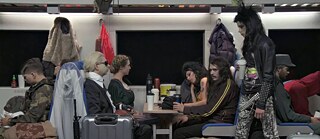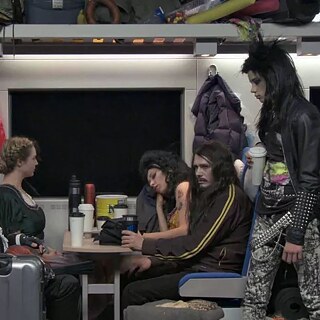"SORRY" by Stefan Panhans
Window Projections|n.b.k. Video-Forum | Window Projections
-
Goethe-Institut Montreal, Montreal
- Language Original version with English subtitles.
- Price Free.
- Part of series: Beyond the screen – Reflections on the public sphere

The Goethe-Institut Montreal, in cooperation with the Neuer Berliner Kunstverein (n.b.k.), presents a screening programme of 20 video works from n.b.k Video-Forum’s extensive video art collection, curated by Anna Lena Seiser (Head of Collection n.b.k. Video-Forum).
The individual films will be shown for a week at a time sunset to 2:00 a.m. on the display windows of the Goethe-Institut at 1626 Boul. St-Laurent, Montréal, Québec, H2X 2T1, Canada and can be viewed on an indoor screen during the Goethe-Institut's opening hours:
2010
09:35 min.
SORRY (2010) displays an oppressive scene in a recreated ICE wagon with a single constant camera position. It is a situation that is immediately familiar: a crowded train, all seats are occupied, and the modest luggage racks hopelessly overcrowded. In search of a niche, more and more people are pushing their way through the narrow aisle and back as it doesn't seem to be any better in the back of the car. Along with them they drag XXL coffee mugs and mostly bizarre luggage. The travelers in Panhans' work also appear familiar, as they depict the doppelgangers of various celebrities. The singer Amy Winehouse, the fashion designer Karl Lagerfeld, the artist Jonathan Meese, the singer Bill Kaulitz (Tokio Hotel) and - even several times - the actor Johnny Depp appear. The presence of Lara Croft and SWAT officers in full gear lend the scene an absurd and oppressive surreality. The only spoken word in the video is a short "Sorry" from Johnny Depp, when he accidentally bumps into Bill Kaulitz and apologizes.
In his photographs, videos, text collages, and drawings, Stefan Panhans (*1967 in Hattingen / Germany, lives in Berlin and Hamburg) focuses primarily on phenomena of everyday life in media society and on manifestations of the urban. Based on research and meticulous observations, his works thematize the effects of the media on body and mind, such as the pressure for self-presentation and self-optimization.
The individual films will be shown for a week at a time sunset to 2:00 a.m. on the display windows of the Goethe-Institut at 1626 Boul. St-Laurent, Montréal, Québec, H2X 2T1, Canada and can be viewed on an indoor screen during the Goethe-Institut's opening hours:
SORRY
Stefan Panhans2010
09:35 min.
SORRY (2010) displays an oppressive scene in a recreated ICE wagon with a single constant camera position. It is a situation that is immediately familiar: a crowded train, all seats are occupied, and the modest luggage racks hopelessly overcrowded. In search of a niche, more and more people are pushing their way through the narrow aisle and back as it doesn't seem to be any better in the back of the car. Along with them they drag XXL coffee mugs and mostly bizarre luggage. The travelers in Panhans' work also appear familiar, as they depict the doppelgangers of various celebrities. The singer Amy Winehouse, the fashion designer Karl Lagerfeld, the artist Jonathan Meese, the singer Bill Kaulitz (Tokio Hotel) and - even several times - the actor Johnny Depp appear. The presence of Lara Croft and SWAT officers in full gear lend the scene an absurd and oppressive surreality. The only spoken word in the video is a short "Sorry" from Johnny Depp, when he accidentally bumps into Bill Kaulitz and apologizes.
In his photographs, videos, text collages, and drawings, Stefan Panhans (*1967 in Hattingen / Germany, lives in Berlin and Hamburg) focuses primarily on phenomena of everyday life in media society and on manifestations of the urban. Based on research and meticulous observations, his works thematize the effects of the media on body and mind, such as the pressure for self-presentation and self-optimization.
Location
Goethe-Institut Montreal
In the form of a local corporation
1626 boul. St-Laurent
Bureau 100
Montreal H2X 2T1
Kanada
In the form of a local corporation
1626 boul. St-Laurent
Bureau 100
Montreal H2X 2T1
Kanada
Window Projections | Every day from sunset to 02:00 AM.
